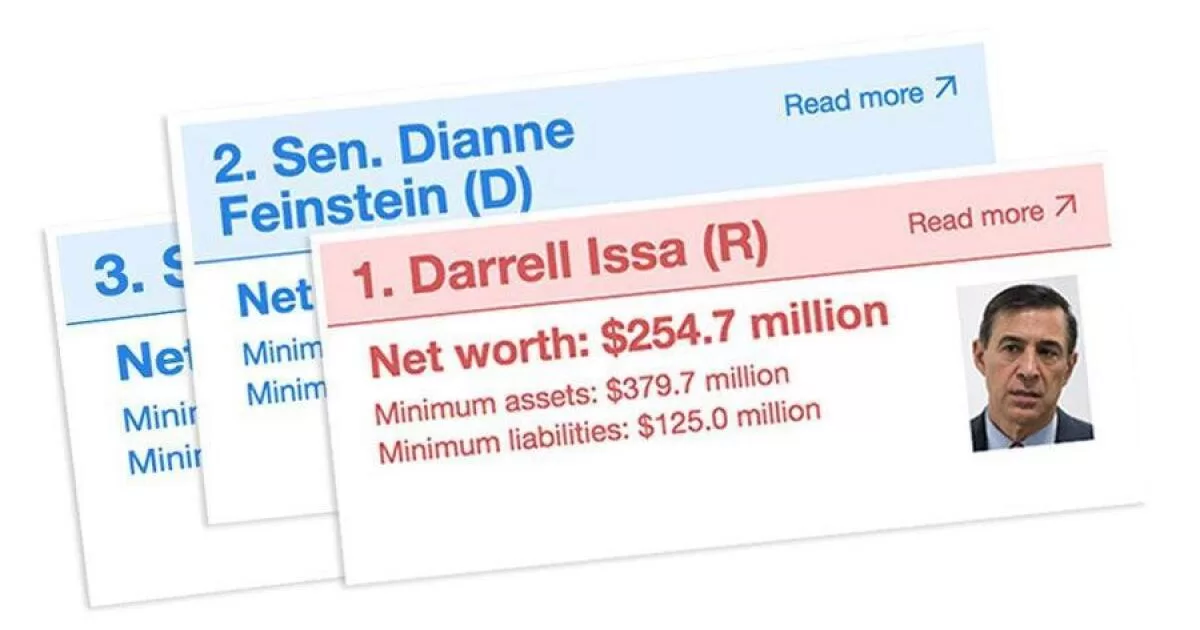California boasts both the richest man and the poorest man in Congress and sends 20 millionaires to Washington, along with a vineyard estate owner and a doctor with a student loan balance of at least $100,000.
Rep. Darrell Issa has the honor of being the richest, according to annual financial disclosure records compiled by Roll Call, a Washington news outlet. The Vista Republican who amassed his fortune as founder of a car alarm giant has a minimum net worth of $254.7 million. He is the voice of the Viper anti-theft car alarm system, which warns: “Please step away from the car.” Read more
At the other end of the list, underneath every other member of Congress, is Rep. David Valadao. The Hanford Republican, a dairy farmer (Valadao and Triple V Dairies), is deep in the red. He listed at least $1.3 million in assets on his disclosure forms for 2014, but is considered the “poorest” in Congress, thanks to $10 million in credit lines for farmland and farming equipment. Read more
California’s delegation disclosed assets worth a minimum of $577.7 million. Without Issa’s whopping total, the other 54 lawmakers collectively reported less than half that: $196.8 million. Bay Area lawmakers are worth many times more than their L.A. area counterparts on average.
The facts might be useful bits of local political trivia, but also highlight how difficult it is to capture precise information about the men and women working in the nation’s Capitol.
The Los Angeles Times used Roll Call’s data to offer Californians an easy way to delve into publicly available information and learn more about the 55 members of the delegation. Our interactive database allows you to filter by gender and party, and lets you use your address to find your own member of Congress.
Search, filter and browse the full list in our interactive database >>
How we did it
The Los Angeles Times list, for the first time, details each asset and liability disclosed by California’s delegation. A lawmaker’s net worth is calculated by subtracting the minimum liabilities disclosed from the minimum assets. HOW MUCH is your member of Congress worth?
Members of Congress are allowed to provide broad ranges for their assets and liabilities, making the totals imprecise figures at best. The ranges start at between $1 and $1,000 and top out at $50 million and greater. So that means Issa could be worth $254.7 million, or he could be worth a lot more. Valadao could hardly be considered poor given his farm’s assets, but the debt skews his minimum net worth into lopsided negative territory.
Disclosure rules require detailed accounting of individual assets — including mutual fund balances and rental property — but lawmakers do not need to list expensive paintings, vintage cars or personal property.
Lawmakers are not required to disclose property owned unless it is earning income, and they also do not need to list their $174,000 annual salaries, putting each and every one of them above the average Californian.
That makes it difficult to compare them with their constituents, since the Census and other data sources evaluate income, not assets and liabilities.
Fast facts
Even if you exclude Republicans Issa and Valadao as the outliers, Democrats in California are worth substantially more than their political rivals. Of the 20 millionaires, 16 are Democrats. The California delegation includes more male millionaires — a statistic that mirrors the overall list.
California has eight members among Roll Call’s 100 richest in Congress.
Senate stats
The state’s two senators, Democrats Dianne Feinstein and Barbara Boxer, rank high on the list. Feinstein is No. 2, with a minimum net worth of $52.8 million. Boxer, who is retiring, has a minimum net worth of $1.09 million. Right behind Boxer on the list is Rep. Loretta Sanchez, a Santa Ana Democrat vying to capture the open Senate seat, with a minimum net worth of $1.05 million. She lists homes in Via Arriba and Santa Ana as her largest assets.
House Minority Leader Nancy Pelosi listed a St. Helena estate and vineyard as among her largest assets. The property on the banks of the Napa River might open up to the likes of Google’s Eric Schmidt, wealthy environmental activist Tom Steyer and Gov. Jerry Brown for conferences, but it’s not her primary residence.
The fourth-richest Californian in Congress, Pelosi has a minimum net worth of $29.3 million. As an example of the broad ranges, the property on Zinfandel Lane is valued between $5,000,001 and $25 million. A description of the property posted on its architect’s website says it was inspired by Palladian villas, and boasts a guesthouse and a Z-shaped pool.
The only reason the San Francisco Democrat had to list it is because she and her husband, Paul Pelosi, collected between $5,001 and $15,000 in income from the sale of grapes grown there. The minority leader’s spokesman and two different state officials were mum on where the grapes are sold and if they would be coming soon to a bottle shop near you.
Collecting pensions
Many in California’s delegation are collecting pensions from state or local governments. Rep. Steve Knight (R-Lancaster) listed on his disclosure form a pension valued between $100,001 and $250,000 from his time in the Los Angeles Police Department. He ranked No. 36 among his 55 colleagues.
Paying it off
As for the student loans, that would be Rep. Raul Ruiz (D-Palm Desert), a former emergency room doctor who listed a liability of between $100,001 and $250,000 in student loan debt. He has twice made headlines for helping passengers during in-flight medical emergencies. Ruiz is No. 32.
For more, go to latimes.com/politics.
MORE ON THE 55: CALIFORNIANS IN CONGRESS
Meet the richest man in Congress
Meet the poorest man in Congress
Pelosi’s vineyard makes her fourth-richest Californian in Congress
Interactive: How much are they worth?
Democrats ask Obama to fund earthquake early warning system
Central Valley Republicans want immigration reform despite speaker’s promise
Congressional Republicans demand plan for collecting El Niño water
